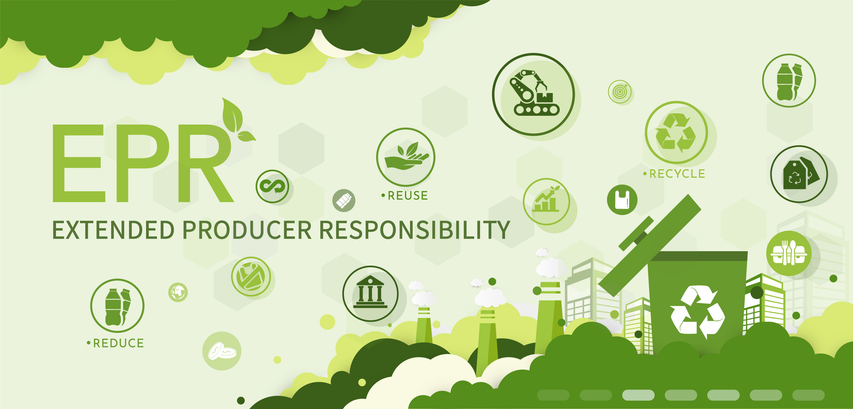We’ll Help You Prepare for Extended Producer Responsibility for Packaging
Extended producer responsibility (EPR) is not a new concept. The paint, battery, and pharmaceutical industries have been complying with these regulations for years. But now, there’s been a significant increase in pressure to extend EPR to packaging. Specifically, plastic and single-use plastics.
The goal is to shift responsibility for the end-of-life of products away from the consumer/taxpayer and toward the producer (brand/importer/distributor). Ultimately, these regulations encourage producers to design packaging with waste reduction and sustainability in mind to help advance the United States to a truly circular economy.
At the time of writing, 12 states have introduced legislation on extended producer responsibility for packaging. Five EPR for packaging bills have passed in the United States. Whether you’re producing packaging for food, healthcare, nutraceuticals, or another industry, this legislation will likely impact you. Here’s what you need to know:

Source: Sustainable Packaging Coalition
What is Extended Producer Responsibility for Packaging?
Extended producer responsibility for packaging is a policy approach that assigns producers both the financial and operational responsibility for the end-of-life of their products. As a whole, this initiative aims to reduce environmental impact by promoting sustainable packaging practices and increasing recycling rates.
Most EPR programs encourage or require packaging product producers to join a collective Producer Responsibility Organization (PRO), though some allow producers to comply individually. With most EPR programs, the producers pay fees to the PRO. The PRO will then distribute the funds to cover the costs required by the program legislation. Part of those costs will typically provide funding for the end-of-life infrastructure (collection, sorting, processing) of covered products.
Covered products are the regulation-defined packaging materials subject to recycling/composting/waste targets and fees. EPR regulation will typically set recycling and recovery targets for covered materials. The PRO and producers are responsible for achieving the target rates set by the legislation within the defined timeline.
Currently, the most recognizable PRO is the Circular Action Alliance (CAA). It was founded by 20 major brands including Amazon, Coca-Cola, General Mills, Walmart, Target, P&G, and more. At the time of writing, the CAA is the only approved PRO to implement EPR for packaging and paper in the United States. The company represents California, Colorado, Maryland, and Oregon.
Facts You Need to Know
If you’re selling products in plastic packaging, you need to know the facts surrounding EPR for packaging.
- EPR fees are based on the type and amount of packaging material being sold in a regulated state. Recyclability, reusability, and other factors are also considered in fee/credit determination. EPRs tend to use the concept of eco-modulated fees. This refers to adjusting rewards or penalties based on the assessed environmental impact of the packaging type.
- Fees imposed on the producers (to cover the cost of the EPR program) are expected to be fractions of a penny per unit.
- Flexible films are expected to be subject to some of the highest EPR for packaging fees.
- Most states have proposed small business exemptions. Thresholds are determined by the regulating state.
- Data suggests there will be minimal to no impact on the consumer’s cost of goods, as many pieces of legislation discourage or prohibit producers from passing along this cost.
- Material that is easier and less expensive to recycle/compost or designed to be recycled/composted (based on the Association of Plastic Recyclers design guide or other relevant industry associations) shall be subject to lower fees. This is according to SB 54 (Allen, Chapter 75, Statutes of 2022), which was signed into law by California Governor Gavin Newsom. Other states will likely follow this same structure.
- The program/material fees determined by the PRO for each producer are subject to adjustments. Credits can be achieved based on source and size reduction/optimization, standardization, post-recycled content percentages, renewable and/or certified compostable materials, and labeling designed to improve consumer behavior related to sorting and proper disposal. This is also according to California law SB 54.
How to Prepare for EPR for Packaging
The best way to stay ahead of EPR legislation is to partner with a packaging provider that’s already designing for compliance. As more states adopt EPR policies, the cost of inaction is growing. If you don’t evolve now, you risk being left behind — or stuck footing the bill for outdated packaging.
PPC Flex’s commercial-ready Thrive line of flexible packaging is specifically engineered to meet or exceed evolving regulatory standards. These solutions are optimized for recyclability and source reduction. Our packaging can offer the performance you expect, with the sustainability standards that states are demanding. Contact us today to see how we can help.
